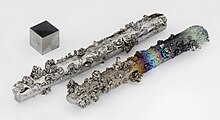Frae Wikipedia, the free beuk o knawledge
Tungsten, 74W |
| Tungsten |
|---|
| Pronunciation | (TUNG-stən) |
|---|
| Appearance | riach, lustrous |
|---|
| Standard atomic weight Ar, std(W) | 7002183840000000000♠183.84(1)[1] |
|---|
| Tungsten in the periodic cairt |
|---|
|
|
| Atomic nummer (Z) | 74 |
|---|
| Group | group 6 |
|---|
| Period | period 6 |
|---|
| Block | d-block |
|---|
| Element category | Transeetion metal |
|---|
| Electron confeeguration | [Xe] 4f14 5d4 6s2[2] |
|---|
| Electrons per shell | 2, 8, 18, 32, 12, 2 |
|---|
| Pheesical properties |
|---|
| Phase at STP | solit |
|---|
| Meltin pynt | 3695 K (3422 °C, 6192 °F) |
|---|
| Bylin pynt | 5828 K (5555 °C, 10031 °F) |
|---|
| Density (near r.t.) | 19.25 g/cm3 |
|---|
| when liquid (at m.p.) | 17.6 g/cm3 |
|---|
| Creetical pynt | 13892 K, MPa |
|---|
| Heat o fusion | 35.3 kJ/mol |
|---|
| Heat o vapourisation | 806.7 kJ/mol |
|---|
| Molar heat capacity | 24.27 J/(mol·K) |
|---|
Vapour pressur
| P (Pa)
|
1
|
10
|
100
|
1 k
|
10 k
|
100 k
|
| at T (K)
|
3477
|
3773
|
4137
|
4579
|
5127
|
5823
|
|
| Atomic properties |
|---|
| Oxidation states | −4, −2, −1, 0, +1, +2, +3, +4, +5, +6 (a mildly acidic oxide) |
|---|
| Electronegativity | Pauling scale: 2.36 |
|---|
| Atomic radius | empirical: 139 pm |
|---|
| Covalent radius | 162±7 pm |
|---|
 Colour lines in a spectral rangeSpectral lines o tungsten Colour lines in a spectral rangeSpectral lines o tungsten |
| Ither properties |
|---|
| Naitural occurrence | primordial |
|---|
| Creestal structur | body-centred cubic (bcc) |
|---|
| Speed o soond thin rod | (annealed) 4620 m/s (at r.t.) |
|---|
| Thermal expansion | 4.5 µm/(m·K) (at 25 °C) |
|---|
| Thermal conductivity | 173 W/(m·K) |
|---|
| Electrical resistivity | 52.8 n Ω·m (at 20 °C) |
|---|
| Magnetic orderin | paramagnetic[3] |
|---|
| Young's modulus | 411 GPa |
|---|
| Shear modulus | 161 GPa |
|---|
| Bulk modulus | 310 GPa |
|---|
| Poisson ratio | 0.28 |
|---|
| Mohs haurdness | 7.5 |
|---|
| Vickers haurdness | 3430 MPa |
|---|
| Brinell haurdness | 2570 MPa |
|---|
| CAS Nummer | 7440-33-7 |
|---|
| History |
|---|
| Diskivery | Torbern Bergman (1781) |
|---|
| First isolation | Juan José Elhuyar an Fausto Elhuyar (1783) |
|---|
| Main isotopes o tungsten |
|---|
|
|
| Decay modes in parentheses are predictit, but hae nae yet been observed |
| | references |
| style="text-align:left"|
|
|
|
in
|
calc from C
|
diff
|
report
|
ref
|
| C
|
3422
|
—
|
—
|
|
|
| K
|
3695
|
3695
|
0
|
|
|
| F
|
6192
|
6192
|
0
|
|
|
| WD
|
6170 !6170 Fahrenheit 3410 Celsius 
|
|
|
[5]
|
| input
|
C: 3422, K: 3695, F: 6192
|
| comment
|
|
| style="text-align:left"|
|
|
|
in
|
calc from C
|
diff
|
report
|
ref
|
| C
|
5555
|
—
|
—
|
|
|
| K
|
5828
|
5828
|
0
|
|
|
| F
|
10031
|
10031
|
0
|
|
|
| WD
|
10701 !10701 Fahrenheit 5930 Celsius 
|
|
|
[5]
|
| input
|
C: 5555, K: 5828, F: 10031
|
| comment
|
|
References
Thir references will appear in the airticle, but this list appears anerly on this page.
- ↑ Meija, Juris; et al. (2016). "Atomic weights of the elements 2013 (IUPAC Technical Report)". Pure and Applied Chemistry. 88 (3): 265–91. doi:10.1515/pac-2015-0305.
- ↑ Berger, Dan. "Why does Tungsten not 'Kick' up an electron from the s sublevel ?". Bluffton College, USA.
- ↑ Magnetic susceptibility of the elements and inorganic compounds, in Handbook of Chemistry and Physics 81st edition, CRC press.
- ↑ "Why does Tungsten not 'Kick' up an electron from the s sublevel ?". Retrieved 15 Juin 2008.
- ↑ a b http://www.cdc.gov/niosh/npg/npgd0645.html.



